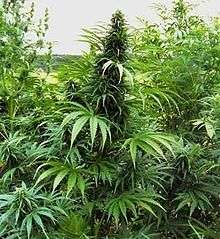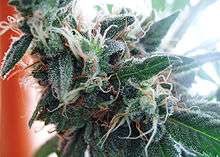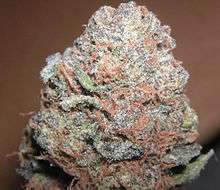Cannabis strain
Cannabis strains are either pure or hybrid varieties of the plant genus Cannabis, which encompasses the species C. sativa, C. indica, and C. ruderalis.
| Part of a series on |
| Cannabis |
|---|
 |
|
|
|
|
Regional
|
|
Variants |
|
Varieties are developed to intensify specific characteristics of the plant, or to differentiate the strain for the purposes of marketing or to make it more effective as a drug. Variety names are typically chosen by their growers, and often reflect properties of the plant such as taste, color, smell, or the origin of the variety.[1] The Cannabis strains referred to in this article are primarily those varieties with recreational and medicinal use. These varieties have been cultivated to contain a high percentage of cannabinoids. Several varieties of cannabis, known as hemp, have a very low cannabinoid content, and are instead grown for their fiber and seed.
Major variety types
Taxonomic paradigm
The two species of the Cannabis genus that are most commonly grown are Cannabis indica and Cannabis sativa.[2] A third species, Cannabis ruderalis, is very short and produces only trace amounts of tetrahydrocannabinol (THC), and thus is not commonly grown for industrial, recreational or medicinal use. However, because Cannabis ruderalis flowers independently of the photoperiod and according to age, it has been used to breed autoflowering strains.[3]
Pure sativas are relatively tall (reaching as high as 4.5 meters), with long internodes and branches, and large, narrow-bladed leaves. Pure indica varieties are shorter and bushier, with wider leaflets. They are often favored by indoor growers for their size. Sativas bloom later than indicas, often taking a month or two longer to mature. The subjective effects of sativas and indicas are said to differ, but the ratio of tetrahydrocannabinol (THC) to cannabidiol (CBD) in most named drug varieties of both types is similar (averaging about 200:1). Unlike most commercially developed strains, indica landraces exhibit plants with varying THC/CBD ratios.[4] Avidekel, a medical marijuana strain developed in Israel, has a very low content of THC but a high content of CBD, limiting its recreational value but maximizing medical effect.[5]
Sativa is known for being a more of a 'head high', energizing strain where psychoactivity is more common, whereas indica, is known for being more of a 'body high' that helps pain and is also used as a sedative.[6]
The informal designation sativa and indica may have various, controversial meanings. Morphologically, the name sativa designates tall plants with narrow leaves, while indica refers to short plants with wide leaves. Among the marijuana community however, sativa rather refers to equatorial varieties producing stimulating psychoactive effects (THC:CBD [almost equal to] 1), whereas indica-type plants from Central Asia are used for relaxing and sedative drugs (THC:CBD > 1) [8].[7]


 Relative size of cannabis types
Relative size of cannabis types
Alternative classifications
There is an increasing discussion about whether the differences between species adequately represents the variability found within the genus cannabis.[8][9][10][11]
There are five chemotaxonomic types of cannabis: one with high levels of THC, one which is more fibrous and has higher levels of CBD, one that is an intermediate between the two, another one with high levels of cannabigerol (CBG), and the last one almost without cannabinoids.[12]
There has also been a recent movement[13] to characterize strains based on their reported subjective effects. For example, WoahStork has used machine learning algorithms to classify strains into six Distinct Activity groups.[14]
Breeding

In addition to pure indica, sativa, and ruderalis varieties, hybrid varieties with varying ratios of these three types are common. For example, the White Widow hybrid containing about 60% indica and 40% sativa ancestry. These hybrid varieties exhibit traits from both parental types. There are also commercial crossbred hybrids which contain a mix of both ruderalis, indica or sativa genes, and are usually autoflowering varieties. These varieties are bred mostly for the medicinal cannabis market, since they are not very appreciated by recreational cannabis users because ruderalis varieties are lower in THC and impart a slightly unpleasant taste. "Lowryder" was an early auto-flowering hybrid that retained the flowering behavior of ruderalis plants, while also producing appreciable amounts of THC and CBD. Autoflowering cannabis varieties have the advantage of being discreet due to their small stature. They also require shorter growing periods, as well as having the additional advantage that they do not rely on a change in the photoperiod to determine when to flower.
Breeding requires pollinating a female cannabis plant with male pollen. Although this occurs spontaneously and ubiquitously in nature, the intentional creation of new varieties typically involves selective breeding in a controlled environment.

When cannabis is cultivated for its psychoactive or medicinal properties, male plants will often be separated from females. This prevents fertilization of the female plants, either to facilitate sin semilla flowering or to provide more control over which male is chosen. Pollen produced by the male is caught and stored until it is needed.
When a male plant of one strain pollinates a female of another strain, the seeds will be F1 hybrids of the male and female. These offspring will not be identical to their parents. Instead, they will have characteristics of both parents. Repeated breeding results in certain characteristics appearing with greater regularity.
It is impossible for a hermaphrodite to create any male-only seeds. A hermaphrodite may create female only seeds and hermaphrodite seeds. Also the female-only seeds may carry the hermaphrodite trait.[15]
Hybridization is the process of plants and animals breeding. Natural wind currents help speed up this hybridization process and promotes a positive growth. Some plants produce many seeds while some produce little to none depending on how it is bred. If seeds are produced traits from both the original parents will be expressed.
Techniques such as mutation breeding are used to develop new strains using irradiation or chemical mutagens such as colchicine.[16]
THC vs. CBD
During the selective breeding process for medical marijuana, THC:CBD ratios are accounted for and accommodated to the needs of the client's preference/illness. Due to the large genetic diversity and different geographical climates and environments, a wide range of strains and properties exist.
THC is associated with the psychoactive high, while CBD is not psychoactive and is purported to have medicinal properties.[17][18][19]
There is little evidence about the safety or efficacy of cannabinoids in the treatment of epilepsy.[20][21]
Genetic stability
In order for there to be genetic stability within a marijuana strain the breeder has to go through selection and breeding, pinpointing the dominant and recessive genes within the two strains being crossed. After analyzing offspring with the preferred traits a breeder is looking for, the breeder will select the preferred traits and continue to breed those offspring to create the desired final product. Selection is a crucial process for a breeder to create a strain, especially if a client is looking for something with specific plant traits the breeder has to ensure that the hybrid's genetic traits have been closed in enough so unwanted traits aren't expressed in future harvests.
Varieties
In a retail market that is decriminalized such as in The Netherlands, where wholesale production is illegal but prosecutions are not always enforced because of the contradiction of the law that is recognised by the courts,[22] competition puts pressure on breeders to create increasingly attractive varieties to maintain market share. Breeders give their strains distinct and memorable names in order to help differentiate them from their competitors' strains, although they may in fact be very similar.
Popular strains are incorporated into new hybrids, which often bear a similar name to their parent. This phenomenon has occurred with Haze and Sour varieties, among others.
Acapulco Gold
Acapulco Gold is a golden-leafed Cannabis sativa strain originally from the Acapulco area of southwest Mexico.[23][24][25]
Bedrocan
Bedrocan is a medicinal cannabis variety cultivated from a Dutch medical marijuana Cannabis sativa L. strain, having a standardized content of THC (22%) and CBD (1%). It is currently cultivated by Bedrocan Nederland, Bedrocan Canada and Bedrocan Česká Republika. It was first introduced in 2003 and is dispensed through pharmacies after prescription from a physician.[26]
Blue Dream

Blue Dream is a hybrid cannabis strain widely used for both medical and recreational purposes first developed in 2003.[27]
Charlotte's Web
Charlotte's Web is a high-cannabidiol (CBD), low-tetrahydrocannabinol (THC) cannabis variety and extract marketed as a dietary supplement under federal law of the United States.[28][29][30] It is produced by the Stanley brothers in Colorado. It does not induce the psychoactive "high" typically associated with recreational marijuana strains that are high in THC.[31] In September 2014, the Stanleys announced that they would ensure that the product consistently contained less than 0.3% THC.[32] Charlotte's Web gained national attention when it was used to treat Charlotte Figi's epileptic seizures.[33][34] Her story has led to her being described as "the girl who is changing medical marijuana laws across America,"[35] as well as the "most famous example of medicinal hemp use".[36]
Green Crack
This strain of cannabis was originally named 'Cush', but was renamed to its current title by rapper Snoop Dogg after noticing its powerful effects.[37] It is a sativa dominant strain first created in Athens, Georgia with parent strains of Skunk #1 and potentially Afghani.[37]
Pineapple Express
Pineapple Express is a hybrid strain of cannabis, originating from parent strains of Trainwreck and Hawaiian.[38] The strain is said to have originated in California, USA, and has a sativa/indica ratio of 60/40.[39] This strain is also known to be the subject of a Hollywood movie titled Pineapple Express.[39]
Purple Kush

Purple Kush is a 100% indica strain of cannabis. This plant "forms a short squat bush with very dense internodes and large fan leaves, staying in the 60 to 90 cm (2 to 3 ft) height range while grown indoors. Purple Kush's foliage exhibits a classic indica growth pattern: a sturdy bush with dark green hues and sometimes hints of purple toward ripeness."[40]
Skunk
Skunk refers to cannabis strains that are strong-smelling and have been likened to the smell of the spray from a skunk. These strains of cannabis are believed to have originated during the early 1990s in the United States prior to larger-scale development and popularization by Dutch growers.[41] Just as with other strains of cannabis, skunk is commonly grown in controlled indoor environments under specialized grow lights, or in a greenhouse when full outdoor conditions are not suitable; skunk strains are hybrids of Cannabis sativa and Cannabis indica.[41]
Sour Diesel

Sour Diesel is a sativa dominant hybrid strain having Chemdog 91 and Super Skunk ancestry. Sour Diesel has an earthy aroma and is attributed with having euphoric, stress relieving and pain relieving properties. Originally developed in 1990, this strain contains a sativa/indica ratio of 90:10, making it suitable for usage during the day.
Super Lemon Haze
Super Lemon Haze is a Cannabis sativa-dominant hybrid strain that was originally bred by Arjan Roskam from Green House Seed Co. in the late 1990s.[42] Super Lemon Haze is an award-winning cultivar, having been recognized as a two-time Amsterdam High Times Cannabis Cup winner from 2008 and 2009,[43] Medical Cannabis Cup, and Spannabis Cup winner.[44]
Tom Cruise Purple
Tom Cruise Purple is a strain of cannabis sold in California by select licensed cannabis clubs. The strain is potent, and is packaged with a picture of the actor Tom Cruise laughing. Tom Cruise Purple is sold by cannabis suppliers in Northern California.[45] Cruise sought out legal advice regarding the product, and considered a lawsuit against its manufacturers.[46][47][48][48][49][50][51][52]
See also
References
- Schwabe, Anna L.; McGlaughlin, Mitchell E. (2019-06-07). "Genetic tools weed out misconceptions of strain reliability in Cannabis sativa: implications for a budding industry". Journal of Cannabis Research. 1 (1): 3. doi:10.1186/s42238-019-0001-1. ISSN 2522-5782.
- Small, E.; Cronquist, A. (1976). "A practical and natural taxonomy for Cannabis". Taxon. 25 (4): 405–435. doi:10.2307/1220524. JSTOR 1220524.
- Greg Green (2001). The Cannabis Grow Bible (4th ed.). p. 47.
- Hillig, Karl W.; Mahlberg, Paul G. (2004). "A chemotaxonomic analysis of cannabinoid variation in Cannabis (Cannabaceae)". American Journal of Botany. 91 (6): 966–975. doi:10.3732/ajb.91.6.966. PMID 21653452.
- Halverson, Nic (July 6, 2012). "Marijuana That Doesn't Get You Stoned". Discovery Channel. Discovery Communications, LLC. Retrieved January 23, 2014.
- Hillig, Karl W.; Mahlberg, Paul G. (June 2004). "A chemotaxonomic analysis of cannabinoid variation in Cannabis (Cannabaceae)". American Journal of Botany. 91 (6): 966–975. doi:10.3732/ajb.91.6.966. PMID 21653452. S2CID 32469533.
- "Gale - Product Login". galeapps.galegroup.com. Retrieved 2019-04-16.
- Piomelli, Daniele; Russo, Ethan B. (2016-01-14). "The Cannabis sativa Versus Cannabis indica Debate: An Interview with Ethan Russo, MD". Cannabis and Cannabinoid Research. 1 (1): 44–46. doi:10.1089/can.2015.29003.ebr. PMC 5576603. PMID 28861479.
- Aizpurua-ppOlaizola, Oier; Omar, Jone; Navarro, Patricia; Olivares, Maitane; Etxebarria, Nestor; Usobiaga, Aresatz (2014-10-23). "Identification and quantification of cannabinoids in Cannabis sativa L. plants by high performance liquid chromatography-mass spectrometry". Analytical and Bioanalytical Chemistry. 406 (29): 7549–7560. doi:10.1007/s00216-014-8177-x. ISSN 1618-2642. PMID 25338935.
- Hazekamp, A.; Fischedick, J. T. (2012-07-01). "Cannabis - from cultivar to chemovar". Drug Testing and Analysis. 4 (7–8): 660–667. doi:10.1002/dta.407. ISSN 1942-7611. PMID 22362625. S2CID 4939961.
- Stockton, Nick (2015-08-27). "Sorry, But the Names for Weed Strains Are Kinda Meaningless". Wired. ISSN 1059-1028. Retrieved 2020-01-12.
- Mandolino, Giuseppe; Bagatta, Manuela; Carboni, Andrea; Ranalli, Paolo; Meijer, Etienne de (2003-03-01). "Qualitative and Quantitative Aspects of the Inheritance of Chemical Phenotype in Cannabis". Journal of Industrial Hemp. 8 (2): 51–72. doi:10.1300/J237v08n02_04. ISSN 1537-7881.
- Renolds, Robert (June 15, 2014). "Therapeutic Satisfaction and Subjective Effects of Different Strains of Pharmaceutical-Grade Cannabis". Journal of Clinical Psychopharmacology. Wolters Kluwer - Lippincott Williams & Wilkins. 34 (3): 344–349. doi:10.1097/JCP.0000000000000129. PMID 24747979. S2CID 7435673.
- Reggente, Nicco (February 15, 2016). "WoahStork's Strain Activity Groups". WoahStork. WoahStork. Retrieved March 15, 2016.
- "Selfing - Cannabis Grow Bible". Kindgreenbuds.com. Retrieved 2017-01-08.
- J, Sirius. "Is Mutant Weed on the Horizon?". High Times. Retrieved 2020-08-12.
- Dufresnes, C; Jan, C; Bienert, F; Goudet, J; Fumagalli, L (2011). "The draft genome and transcriptome of Cannabis sativa". PLOS ONE. 12 (1): e0170522. doi:10.1371/journal.pone.0170522. PMC 5249207. PMID 28107530.
- Dufresnes, Christophe; Jan, Catherine; Bienert, Friederike; Goudet, Jérôme; Fumagalli, Luca (2017). "Broad-Scale Genetic Diversity of Cannabis for Forensic Application". PLOS ONE. 12 (1): e0170522. Bibcode:2017PLoSO..1270522D. doi:10.1371/journal.pone.0170522. PMC 5249207. PMID 28107530.
- "CBD vs. THC: What's The Difference?". CBD International. 2017.
- Melville, Nancy A. (August 14, 2013), Seizure Disorders Enter Medical Marijuana Debate, Medscape Medical News, retrieved January 14, 2014
- Tedesco, Laura (December 8, 2014), Why Parents of Children with Epilepsy Are Increasingly Turning to Marijuana, yahoo.com, retrieved February 9, 2016,
'Charlotte’s Web is high in CBD and low in THC,' ... To many in the medical community, these parents are relying, at best, on shaky science. A 2013 Cochrane review of studies examining CBD as a treatment for epilepsy concluded that, due to the dearth of large, high-quality studies, 'the safety of long-term cannabidiol treatment cannot be reliably assessed.'
- "Dutch court refuses to punish illegal cannabis growers". Phys.org. 2014-10-20. Retrieved 2017-01-08.
- Partridge, Eric (2006). The New Partridge Dictionary of Slang and Unconventional English: A-I. Taylor & Francis. p. 4. ISBN 978-0-415-25937-8.
- Central Intelligence Agency (13 December 2013). The CIA World Factbook 2012. Skyhorse Publishing Company, Incorporated. p. 44. ISBN 978-1-62873-181-1.
- Green, Jonathon (2 October 2013). Dictionary of Jargon. Routledge. p. 4. ISBN 978-1-317-90818-0.
- Frederike K. Engels; Floris A. de Jong; Ron H.J. Mathijssen; Joëlle A. Erkens; Ron M. Herings; Jaap Verweij (2007), "Medicinal cannabis in oncology", European Journal of Cancer, 43 (18): 2638–2644, doi:10.1016/j.ejca.2007.09.010, PMID 17976975
- Backes, Michael (September 9, 2014). Cannabis Pharmacy: The Practical Guide to Medical Marijuana. Black Dog & Leventhal. pp. 124–125. ISBN 9781579129514. Retrieved 2017-03-12.
- Realm of Caring Foundation (2014), Realm of Caring: About Us, retrieved May 31, 2014
- Martinez, Tracy (March 7, 2014), Touring the marijuana facility growing plants to save children's lives, Al Jazeera America, retrieved March 7, 2014
- Cordell, Kasey (May 1, 2014), Tangled Web, 5280 [The Denver Magazine], retrieved April 19, 2015
- Allen, Greg (January 16, 2014), Florida Bill Would Allow Marijuana Extract For Child Seizures, National Public Radio, retrieved January 16, 2014
- Waltz, Vanessa (September 18, 2014), Realm of Caring Announces Charlotte's Web to be Shipped to All 50 US States, Ladybud Magazine, archived from the original on October 20, 2014, retrieved September 19, 2014
- Weed: Dr. Sanjay Gupta Reports (full transcript), CNN, August 11, 2013, retrieved January 1, 2014
See full CNN video. - Weed 2: Cannabis Madness, Dr. Sanjay Gupta Reports (full transcript), CNN, March 11, 2014, retrieved March 15, 2014
CNN's main page. See full CNN video. - Osborne, Hannah (June 20, 2014), Charlotte Figi: The Girl Who is Changing Medical Marijuana Laws Across America, International Business Times, retrieved June 22, 2014
- Schaaf, Melissa (September 25, 2014), Hemp Industry Overview, Boulder Weekly, retrieved September 26, 2014
- "Green Crack". www.wikileaf.com. Retrieved 2020-04-15.
- "Pineapple Express - Cannabis Strain Information". Weedmaps. Retrieved 2020-04-15.
- "Pineapple Express Strain (Buy Online) | Side Effects, Grow Tips & More". Learn Sativa | CBD Dispensary & Cannabis College. 2019-04-14. Retrieved 2020-04-15.
- Rosenthal, Ed (2007). More Marijuana Varieties from the World's Great Seed Breeders, p. 134. ISBN 9780932551795.
- "Skunk". Archived from the original on 2016-03-06.
- "Super Lemon Haze Strain". allbud. Retrieved 4 February 2020.
- "Super Lemon Haze". Leafly. Retrieved 4 February 2020.
- Michaels, Dan (November 14, 2017). Green: A Pocket Guide to Pot. Chronicle Books. p. 315. ISBN 978-1452166421. Retrieved 4 February 2020.
- Krugman, Milt (April 8, 2008). "Tom Cruise fuming". Bucks County Courier Times. Levittown, Pennsylvania.
- "Lanzan producto de marihuana con la imagen de Cruise". Esmas.com (in Spanish). www.esmas.com. April 13, 2008. Archived from the original on January 11, 2010. Retrieved March 25, 2010.
- "Tom Cruise 'goes to pot' over marijuana link". The New Zealand Herald. APN News & Media. April 7, 2008.
- "Medical high jinks leave Tom Cruise camp fuming". New York Daily News. Mortimer Zuckerman. April 4, 2008. Retrieved March 25, 2010.
- Reardanz, Karen (April 4, 2008). "Cruise Fumes Over Marijuana Association". San Francisco Chronicle. Retrieved March 25, 2010.
- Saar, Mayrav (April 4, 2008). "TomKat in a Huff over Tom Pot". E! Online. E! Entertainment Television, Inc. Retrieved March 25, 2010.
- WENN (April 4, 2008). "Cruise fumes over marijuana association". World Entertainment News Network. Comtex.
- "Report: 'Tom Cruise Purple' Medical Marijuana Has Actor Smoking Mad". Fox News Channel. Fox News Network, LLC. April 4, 2008. Retrieved 25 March 2010.
External links
